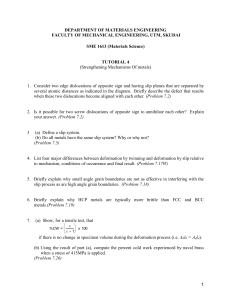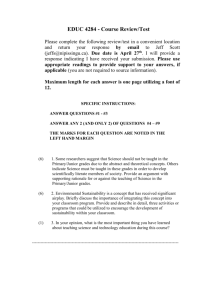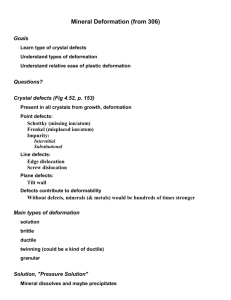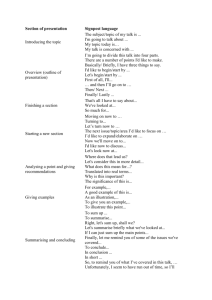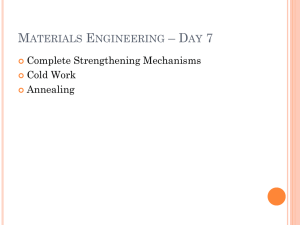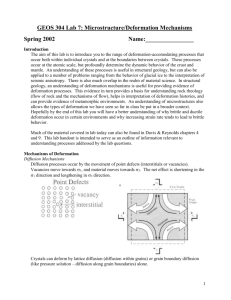Chap 7 Learn Obj
advertisement
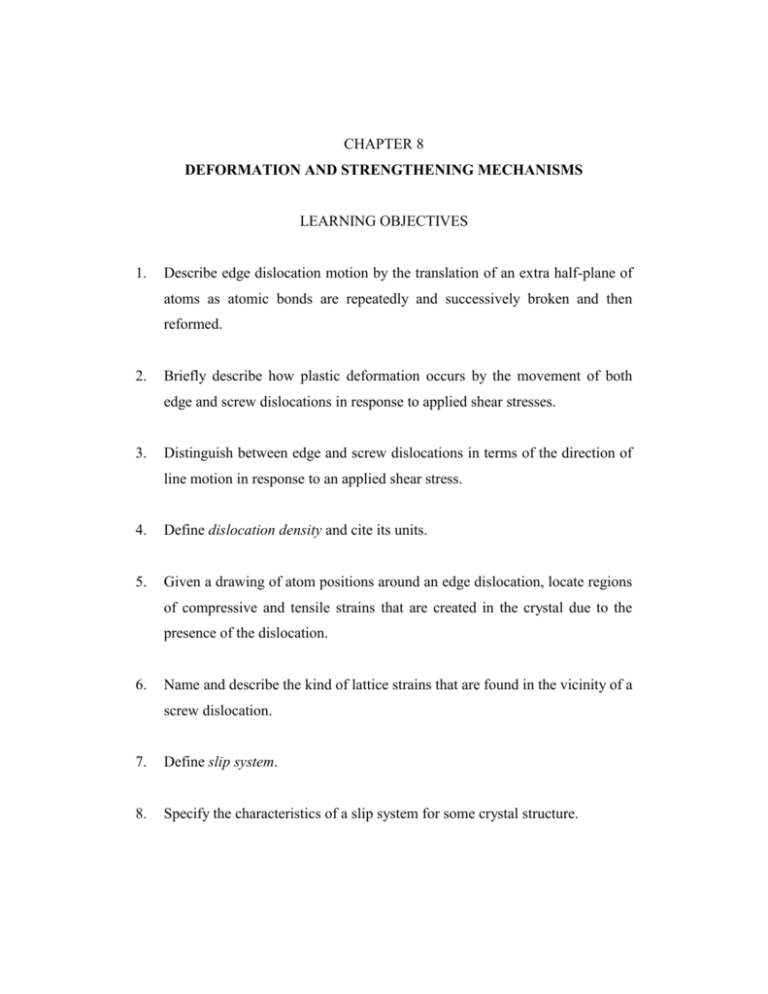
CHAPTER 8 DEFORMATION AND STRENGTHENING MECHANISMS LEARNING OBJECTIVES 1. Describe edge dislocation motion by the translation of an extra half-plane of atoms as atomic bonds are repeatedly and successively broken and then reformed. 2. Briefly describe how plastic deformation occurs by the movement of both edge and screw dislocations in response to applied shear stresses. 3. Distinguish between edge and screw dislocations in terms of the direction of line motion in response to an applied shear stress. 4. Define dislocation density and cite its units. 5. Given a drawing of atom positions around an edge dislocation, locate regions of compressive and tensile strains that are created in the crystal due to the presence of the dislocation. 6. Name and describe the kind of lattice strains that are found in the vicinity of a screw dislocation. 7. Define slip system. 8. Specify the characteristics of a slip system for some crystal structure. 9. Specify the slip systems for face-centered cubic and body-centered cubic crystal structures. 10. Define resolved shear stress and critical resolved shear stress. 11. Compute the resolved shear stress on a specified plane given the value of the applied tensile stress, as well as 1) the angle between the normal to the slip plane and the applied stress direction, and 2) the angle between the slip and stress directions. 12. Describe the nature of plastic deformation, in terms of dislocation motion, for a single crystal that is pulled in tension. 13. Briefly explain how the grain structure of a polycrystalline metal is altered when it is plastically deformed. 14. Briefly describe, from an atomic perspective, how plastic deformation results from the formation of mechanical twins. 15. Cite two differences between deformation by slip and deformation by twinning. 16. Explain why and describe how the yield strength of a metal is related to the ability of dislocations to move. 17. Describe how grain boundaries impede dislocation motion and why a metal having small grains is stronger than one having large grains. 18. Given a plot of yield strength versus d-1/2 (d being the average grain size), be able to determine the values of 0 and ky, and also the yield strength at a specified value of d. 19. Briefly describe the phenomenon of solid-solution strengthening. 20. Briefly explain solid-solution strengthening for substitutional impurity atoms in terms of lattice strain interactions with dislocations. 21. Describe the phenomenon of strain hardening (or cold-working) in terms of (a) changes in mechanical properties, and (b) stress-strain behavior. 22. Given the original and deformed cross-sectional dimensions of a metal specimen that has been cold-worked, compute the percent cold work. 23. Schematically plot tensile strength, yield strength, and ductility versus percent cold work for a metal specimen. 24. Briefly describe the phenomenon of strain hardening in terms of dislocations and strain field interactions. 25. Cite three characteristics/properties that become altered when a metal is plastically deformed. 26. Briefly describe the changes that take place as a metal experiences recovery. 27. Describe recrystallization in terms of both the alteration of microstructure and mechanical characteristics of the material. 28. Cite the driving force for recrystallization. 29. Make a schematic plot of how the room temperature tensile strength and ductility vary with temperature (at a constant heat-treating time) in the vicinity of the recrystallization temperature, for a metal that was previously cold-worked. 30. Define recrystallization temperature. 31. Name two factors that influence the recrystallization temperature of a metal or alloy, and then note in what way they influence the recrystallization temperature. 32. Make a distinction between hot-working and cold-working. 33. Describe a procedure that may be used to reduce the cross-sectional area of a cylindrical specimen, given its original and deformed radii, and, in addition, the required strength and ductility after deformation. 34. Describe the phenomenon of grain growth from both macroscopic and atomic level perspectives. 35. Cite the driving force for grain growth. 36. For some polycrystalline material, given a value for the diameter exponent (n), and, in addition, the grain diameters at two different times at an elevated temperature, be able to compute the following: (a) the original grain diameter, and (b) the grain diameter after yet another time. 37. Briefly describe the mechanism by which plastic deformation occurs for each of crystalline and noncrystalline ceramic materials. 38. On the basis of slip considerations, briefly explain why crystalline ceramic materials are so brittle. 39. Briefly define viscosity and cite the units in which it is expressed. 40. Briefly describe the mechanism by which semicrystalline polymers elastically deform. 41. Describe/sketch the various stages in the elastic deformation of a semicrystalline (spherulitic) polymer. 42. Describe/sketch the various stages in the plastic deformation of a semicrystalline (spherulitic) polymer. 43. Briefly describe the effects of annealing on a semicrystalline polymer that has been permanently deformed. 44. Discuss the influence of the following factors on polymer tensile modulus and/or strength: (a) molecular weight, (b) degree of crystallinity, (c) extent of crosslinking, (d) predeformation, and (e) the heat treating of undeformed materials. 45. (a) Briefly describe the molecular mechanism by which elastomeric polymers deform elastically. (b) Now cite the driving force for the recoil of an elastomeric material. 46. Note four criteria that are necessary for a polymer to exhibit elastomeric behavior. 47. Briefly describe the vulcanization process and what effect it has on the mechanical characteristics of elastomeric materials.
